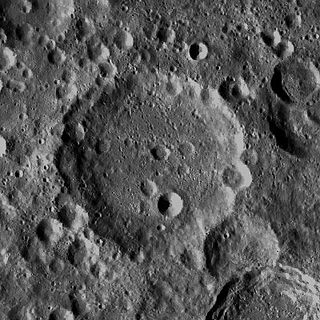
Anderson is a lunar impact crater that is located on the far side of the Moon. It is located to the northwest of the crater Sharonov, and the satellite crater Sharanov X is attached to the southeast rim of Anderson. To the northeast is the peculiar formation Buys-Ballot, and to the east-southeast lies the larger crater Spencer Jones.

Argelander is a lunar impact crater that is located in the south-central highlands of the Moon. It was named after the German astronomer Friedrich Argelander. It lies in the midpoint between the smaller crater Vogel in the north and the larger Airy to the south. To the northwest is the worn remnant of Parrot. Just to the west is a shallow cleft in the surface that follows a course to the north-northwest, intersecting the southeast rim of Parrot.
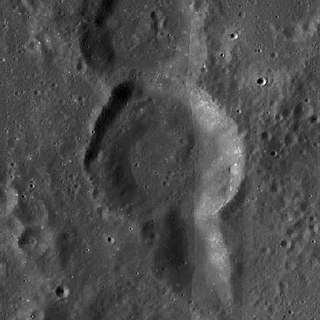
Vogel is a small lunar impact crater located to the southeast of Albategnius. It was named after the German astronomer Hermann Carl Vogel. It is the smallest member of a trio of craters that increase in size from north to south, consisting of Vogel, Argelander and Airy. To the west is the remnant of the crater Parrot.

Fernelius is a lunar impact crater located in the southern highlands just to the north of the walled plain Stöfler. It was named after 16th century French astronomer Jean Fernel. The crater Kaiser is located next to the northwest rim of Fernelius. To the north-northwest are the craters Nonius and Walther. Southeast of Fernelius is the crater cluster of Miller, Nasireddin, Huggins, and Orontius.

Bonpland is the remains of a lunar impact crater that is attached to the walled plain Fra Mauro to the north and Parry to the east. The intersection of their rims forms a three-pointed mountainous rise. To the southeast is the small crater Tolansky. Bonpland lies on the eastern edge of Mare Cognitum. It is named after Aimé Bonpland, a French explorer and botanist.

Doppelmayer is the remains of a lunar impact crater that lies on the southwest edge of Mare Humorum. It was named after the German mathematician and astronomer Johann Gabriel Doppelmayr. To the south-southeast is another flooded crater designated Lee, and to the southeast is Vitello. Just to the east-northeast of Doppelmayer lies the nearly submerged crater Puiseux.

Arrhenius is a lunar impact crater that is located just on the far side of the Moon, near the southwest limb. In this location the vicinity of the crater can be viewed during favorable librations, although it is viewed from on edge. To the south-southeast is the worn crater Blanchard, and De Roy lies further to the west.

Artemʹev is a lunar impact crater that is located on the far side of the Moon. The rim of this crater has been modified by subsequent impacts in the vicinity, with an inward bulge along the southwest edge and a worn impact lying across the north rim. The satellite crater Artemʹev G is partly overlain by the southeast rim of Artemʹev. The crater interior is relatively flat, and marked only by tiny craterlets.
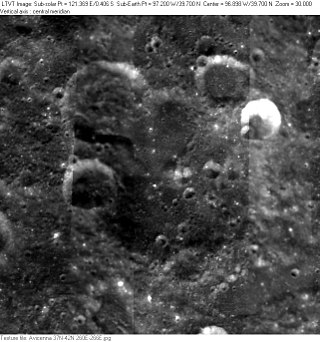
Avicenna is a lunar impact crater that lies on the far side of the Moon, just beyond the western limb on the northern rim of the Lorentz basin. It is named after the Persian polymath Avicenna. It lies to the north-northwest of the larger crater Nernst, and to the southeast of Bragg.

Babbage is an ancient lunar impact crater that is located near the northwest limb of the Moon, named after Charles Babbage. It is attached to the southeastern rim of the prominent crater Pythagoras. The crater remnant named South intrudes into the southeastern floor of Babbage.

Berkner is a lunar impact crater that is located on the far side of the Moon, just past the western limb. It is attached to the east-southeast rim of the crater Parenago. Just to the south is the Robertson, and to the southeast is Helberg.

Bronk is an eroded crater that lies on the far side of the Moon, out of sight from the Earth. It lies to the southeast of the larger crater Kovalevskaya. Less than one crater diameter to the east-northeast is the smaller crater Bobone.

Casatus is a lunar impact crater that is located near the southern limb of the Moon. The north-northeast rim of the crater overlies a portion of the slightly larger crater Klaproth. Along the western rim, Casatus A intrudes somewhat into the interior, producing an inward-bowing rim. To the southeast of Casatus is Newton.

Cook is a lunar impact crater that lies in the western part of the Mare Fecunditatis, just to the southeast of the prominent crater Colombo. To the southwest is Monge.

Demonax is a lunar impact crater near the southern limb of the Moon. This location makes the crater difficult to observe due to foreshortening. The crater is also illuminated at a very low angle, when it is in the sunlit side. Demonax lies just to the north of the crater Scott, one of the south polar formations. To the north-northwest is Boguslawsky.

Chernyshev is a lunar impact crater that is located in the northern part of the Moon's far side. It lies to the northeast of the crater Chandler, and to the southeast of the walled plain D'Alembert.
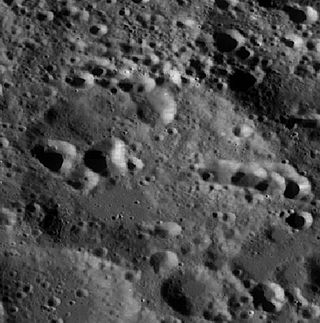
Chandler is a lunar impact crater in the northern hemisphere, on the Moon's far side. It lies to the southeast of the large walled plain D'Alembert, and southeast of the slightly smaller Chernyshev crater.

Cockcroft is a lunar impact crater that is situated on the far side of the Moon from the Earth, so that it has only been observed and photographed from orbit. It lies to the northeast of the larger crater Fitzgerald, and southeast of Evershed.
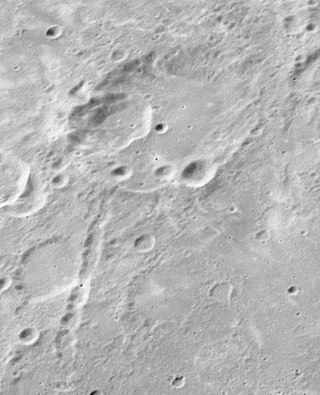
Dziewulski is a lunar impact crater on the far side of the Moon. It lies between the craters Edison to the north and Popov to the south. The outer rim of this crater has been considerably worn by impacts, particularly along the southwest quadrant where the satellite crater Dziewulski Q overlies the rim and the interior floor. The northern rim is also heavily disrupted, and several small crater lie along the southeast rim. The interior floor and surrounding terrain has been resurfaced.

Denning is a lunar impact crater that is located on the far side of the Moon. It lies about midway between the craters Levi-Civita to the south and Marconi to the north-northeast. About two crater diameters to the southeast is the huge walled plain Gagarin.























